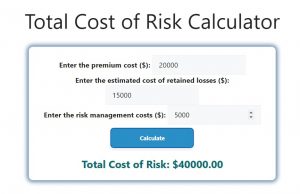About Total Cost of Risk Calculator (Formula)
The Total Cost of Risk (TCOR) Calculator is an essential tool for businesses looking to assess and manage their risk exposure effectively. Understanding the total cost associated with risks allows organizations to make informed decisions about risk management strategies, insurance coverage, and budgeting. By calculating TCOR, businesses can identify areas where they can improve their risk management practices and ultimately save money while protecting their assets.
Formula
The formula for calculating the Total Cost of Risk is:
TCOR = Premium Cost + Estimated Cost of Retained Losses + Risk Management Costs
Where:
- Premium Cost refers to the amount paid for insurance coverage.
- Estimated Cost of Retained Losses includes the anticipated losses that the business is willing to bear before insurance kicks in.
- Risk Management Costs cover expenses related to risk mitigation strategies, such as safety programs and compliance measures.
How to Use
Using the Total Cost of Risk Calculator is a straightforward process. Follow these steps:
- Gather Data: Collect information on your insurance premium costs, estimated retained losses, and risk management expenses.
- Input Values: Enter the collected data into the respective fields of the TCOR Calculator.
- Calculate TCOR: Click the “Calculate” button to determine your total cost of risk. This will provide you with a clear picture of your overall risk expenses.
- Analyze Results: Review the results to identify areas where you can reduce costs or improve risk management strategies.
Example
Let’s consider a hypothetical company with the following data:
- Premium Cost: $20,000
- Estimated Cost of Retained Losses: $15,000
- Risk Management Costs: $5,000
Using the TCOR formula:
TCOR = Premium Cost + Estimated Cost of Retained Losses + Risk Management Costs
TCOR = $20,000 + $15,000 + $5,000
TCOR = $40,000
In this example, the Total Cost of Risk for the company is $40,000, highlighting the total financial impact of risk on the business.

FAQs
- What is Total Cost of Risk (TCOR)?
TCOR is the total financial impact of risk on an organization, including insurance premiums, retained losses, and risk management costs. - Why is calculating TCOR important?
Calculating TCOR helps organizations understand their risk exposure and costs, enabling them to make informed decisions about risk management. - How often should I calculate TCOR?
It is advisable to calculate TCOR annually or when significant changes occur in your risk profile or business operations. - What factors influence TCOR?
Factors include the type of business, industry regulations, insurance coverage, and the effectiveness of risk management strategies. - Can TCOR help in budgeting?
Yes, understanding TCOR assists businesses in budgeting for risk management and insurance expenses more accurately. - What are retained losses?
Retained losses refer to the costs associated with losses that the organization chooses to bear rather than transferring them through insurance. - How can I reduce my TCOR?
Strategies to reduce TCOR include improving safety protocols, investing in risk management programs, and shopping for competitive insurance rates. - What are risk management costs?
Risk management costs are expenses related to activities and programs designed to mitigate risks, such as safety training and compliance audits. - Is TCOR the same for all businesses?
No, TCOR varies depending on the size, type, and industry of the business, as well as its specific risk profile. - How can technology assist in calculating TCOR?
Technology can streamline data collection, enhance accuracy, and provide analytics for better risk management decisions. - What role do insurance premiums play in TCOR?
Insurance premiums are a significant component of TCOR, reflecting the cost of transferring risk to an insurer. - Can TCOR be used for personal finance?
While TCOR is primarily used in business, individuals can apply similar concepts to assess personal insurance and risk management costs. - How does TCOR relate to overall business performance?
A lower TCOR can indicate better risk management, leading to improved profitability and stability for a business. - What is the difference between TCOR and ROI?
TCOR focuses on the total costs associated with risk, while ROI (Return on Investment) measures the profitability of investments relative to their costs. - Are there software tools available for TCOR calculations?
Yes, many risk management software solutions include TCOR calculators as part of their features. - How does risk appetite affect TCOR?
Organizations with a higher risk appetite may have lower insurance premiums but may face higher retained losses, affecting TCOR. - Can TCOR be affected by regulatory changes?
Yes, changes in regulations can impact risk management practices and insurance costs, influencing TCOR. - Is TCOR relevant for non-profit organizations?
Yes, non-profit organizations can benefit from understanding their TCOR to manage resources effectively and minimize risks. - How can I communicate TCOR findings to stakeholders?
Presenting TCOR data visually through graphs and charts can help stakeholders understand the financial impact of risks. - Can TCOR change over time?
Yes, TCOR can fluctuate based on changes in the business environment, risk profile, and effectiveness of risk management strategies.
Conclusion
The Total Cost of Risk Calculator is a vital tool for organizations aiming to manage their risk exposure effectively. By understanding and calculating TCOR, businesses can make informed decisions about insurance coverage, budgeting, and risk management strategies. This article has outlined the formula, how to use the calculator, provided an example, and answered common questions related to TCOR. Utilizing this knowledge enables organizations to optimize their risk management efforts and enhance their overall financial performance.